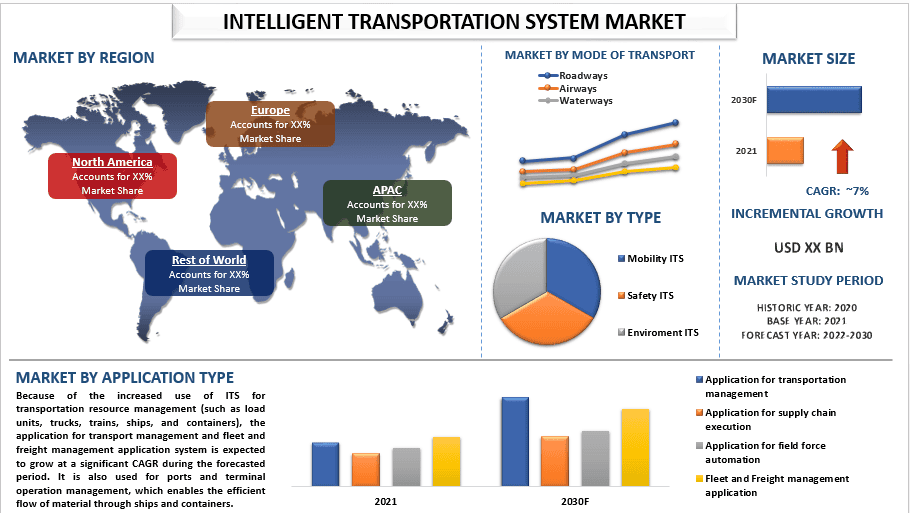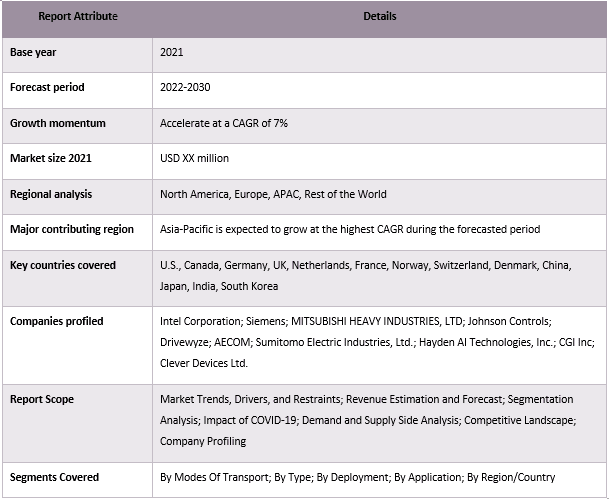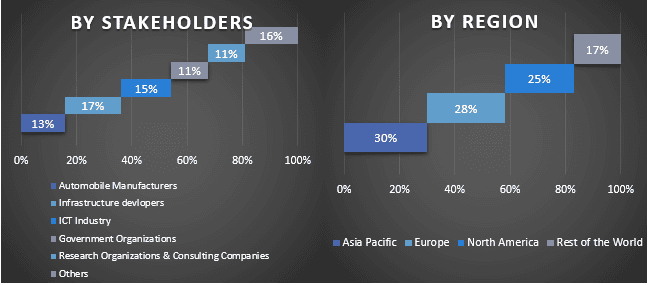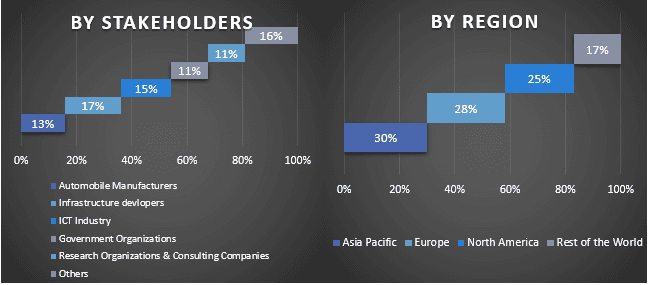Emphasis on Modes of Transport (Roadways, Airways, Waterways, and Railways), Type (Mobility ITS, Safety ITS, and Environment ITS), DeploymentType (Intelligent Infrastructure and Intelligent Vehicles), and Application Type (Application for Transportation Management, Application for Supply Chain Execution, Application for Field Force Automation, and Fleet and Freight Management Application) Region/Country.

The intelligent transportation system market is expected to grow at a significant CAGR of around 7% during the forecast period.
Traffic is becoming one of the major issues in developed and developing economies, with the increasing density of vehicles on the roads leading to road traffic congestion and accidents, moreover, a great deal of inconvenience, pollution, and time loss has increased due to the slow-moving traffics pertaining to a large number of economic losses due to these inefficiencies in the traffic management hence traditional methods of controlling the traffic is getting obsolete and intelligent and more effective equipment are becoming popular in the era of rapid technological advancements in the field of information and communication technologies and collectively are called ITS.
ITS is a computerized system having a very wide range of applications in vehicle transportation which is by interacting with high-end sensors of smartphones like (GPS, accelerometer, proximity sensor, gyroscopes, microphones, and cameras) and equipment installed on the infrastructure. Moreover, ITS is being deployed for real-time navigation, traffic updates, lane discipline, and predicting travel time. Additionally, ITS has been proven very efficient in facilitating the movement of logistics and heavy commercial vehicles of traffic by giving them more open passage, increasing economic efficiency as well as keeping the roads safer for other drivers. Furthermore, other ITS applications include real-time traffic information, roadside weather information systems, dynamic traffic signs, electronic toll collection, variable parking fees, and pre-booking of parking areas during peak hours, etc.
Some of the major players operating in the market include Intel Corporation; Siemens; MITSUBISHI HEAVY INDUSTRIES, LTD; Johnson Controls; Drivewyze; AECOM; Sumitomo Electric Industries, Ltd.; Hayden AI Technologies, Inc.; CGI Inc; Clever Devices Ltd.
Insights Presented in the Report
“Amongst application type, application for transport management and fleet and freight management application segment is going to grow at a significant CAGR during the forecasted period”
Based on application, the market is segmented into, applications for transportation management, application for supply chain execution, application for field force automation, and fleet and freight application management. Because of the increased use of ITS for transportation resource management (such as load units, trucks, trains, ships, and containers), the application for transport management and fleet and freight management application system is expected to grow at a significant CAGR during the forecasted period. It is also used for ports and terminal operation management, enabling the efficient material flow through ships and containers. Furthermore, ITS allows for the tracking of goods and vehicles as well as the provision of real-time traffic information, which enhances traffic flow and the efficient use of roads, facilitating the timely and secure arrival of logistics. For instance, on September 2022, Aboitiz Data Innovation (ADI) and Shiptek Solutions Corporation (Shiptek), a Philippine-based software development company, recently announced a partnership to further drive the operationalization of Data Science and Artificial Intelligence (DSAI) in the logistics industry.
“Asia Pacific dominated the intelligent transportation system market in 2021.”
The intelligent transportation system market in the Asia Pacific region held the largest market share in the year 2021. Owing to the reason like the migration of the huge population into cities, which is increasing the traffic density and mobility among the fixed concentrated space, hence need to efficiently manage the traffic has increased in order to prevent traffic congestion and facilitate the free flow of traffic and safety of the commuters, without needing to develop new infrastructure, making ITS the most cost-effective choice to do it, which increases the efficiency of the use of existing infrastructure. Moreover, with rising per capita income of the consumers has led to an increase in the number of vehicles on the roads both commercial and personal vehicles due to increased economic activity as consumption has risen, hence rising the demand for the ITS in emerging countries where the population is very high but the number of cities is less and the pace of new infrastructure development is less.
Intelligent Transportation System Market Report Coverage

Reasons to buy this report:
Customization Options:
The global intelligent transportation system market can further be customized as per the requirement or any other market segment. Besides this, UMI understands that you may have your own business needs, hence feel free to connect with us to get a report that completely suits your requirements.
1. Market Introduction
2. Research Methodology Or Assumption
3. Market Synopsis
4. Executive Summary
5. Global Intelligent Transportation System Market Covid-19 Impact
6. Global Intelligent Transportation System Market Revenue, 2020-2028f
7. Market Insights By Modes Of Transport
8. Market Insights By Type
9. Market Insights By Deployment Type
10. Market Insights By Application Type
11. Market Insights By Region
12. Intelligent Transportation System Market Dynamics
13. Intelligent Transportation System Market Opportunities
14. Intelligent Transportation System Market Trends
15. Demand And Supply-side Analysis
16. Value Chain Analysis
17. Case Study
18. Strategic Insights
19. Competitive Scenario
20. Company Profiled
21. Disclaimer
Research Methodology for the Intelligent Transportation System Market Analysis (2022-2028)
Analyzing the historical market, estimating the current market, and forecasting the future market of the global intelligent transportation system market were the three major steps undertaken to create and analyze the adoption of intelligent transportation systems in major regions globally. Exhaustive secondary research was conducted to collect the historical market numbers and estimate the current market size. Secondly, to validate these insights, numerous findings and assumptions were taken into consideration. Moreover, exhaustive primary interviews were also conducted, with industry experts across the value chain of the global intelligent transportation system market. Post assumption and validation of market numbers through primary interviews, we employed a top-down/bottom-up approach to forecasting the complete market size. Thereafter, market breakdown and data triangulation methods were adopted to estimate and analyze the market size of segments and sub-segments of the industry pertains to. Detailed methodology is explained below:
Analysis of Historical Market Size
Step 1: In-Depth Study of Secondary Sources:
Detail secondary study was conducted to obtain the historical market size of the intelligent transportation system market through company internal sources such as annual reports & financial statements, performance presentations, press releases, etc., and external sources including journals, news & articles, government publications, competitor publications, sector reports, third-party database, and other credible publications.
Step 2: Market Segmentation:
After obtaining the historical market size of the intelligent transportation system market, we conducted a detailed secondary analysis to gather historical market insights and share for different segments & sub-segments for major regions. Major segments are included in the report as modes of transport, by types of ITS, by deployment type, and by application. Further country-level analyses were conducted to evaluate the overall adoption of testing models in that region.
Step 3: Factor Analysis:
After acquiring the historical market size of different segments and sub-segments, we conducted a detailed factor analysis to estimate the current market size of the intelligent transportation system market. Further, we conducted factor analysis using dependent and independent variables such as modes of transport, by types of ITS, by deployment type, and by application of the intelligent transportation system market. A thorough analysis was conducted for demand and supply-side scenarios considering top partnerships, mergers and acquisitions, business expansion, and product launches in the intelligent transportation system market sector across the globe.
Current Market Size Estimate & Forecast
Current Market Sizing: Based on actionable insights from the above 3 steps, we arrived at the current market size, key players in the global intelligent transportation system market, and market shares of the segments. All the required percentage shares split, and market breakdowns were determined using the above-mentioned secondary approach and were verified through primary interviews.
Estimation & Forecasting: For market estimation and forecast, weights were assigned to different factors including drivers & trends, restraints, and opportunities available for the stakeholders. After analyzing these factors, relevant forecasting techniques i.e., the top-down/bottom-up approach were applied to arrive at the market forecast for 2028 for different segments and sub-segments across the major markets globally. The research methodology adopted to estimate the market size encompasses:
Market Size and Share Validation
Primary Research: In-depth interviews were conducted with the Key Opinion Leaders (KOLs) including Top Level Executives (CXO/VPs, Sales Head, Marketing Head, Operational Head, Regional Head, Country Head, etc.) across major regions. Primary research findings were then summarized, and statistical analysis was performed to prove the stated hypothesis. Inputs from primary research were consolidated with secondary findings, hence turning information into actionable insights.
Split of Primary Participants in Different Regions

Market Engineering
The data triangulation technique was employed to complete the overall market estimation and to arrive at precise statistical numbers for each segment and sub-segment of the global intelligent transportation system market. data was split into several segments & sub-segments post studying various parameters and trends in the areas such as modes of transport, by types of ITS, by deployment type, and application
The main objective of the Global Intelligent Transportation System Market Study
The current & future market trends of the global intelligent transportation system market were pinpointed in the study. Investors can gain strategic insights to base their discretion for investments on the qualitative and quantitative analysis performed in the study. Current and future market trends determined the overall attractiveness of the market at a regional level, providing a platform for the industrial participant to exploit the untapped market to benefit from a first-mover advantage. Other quantitative goals of the studies include:

Customers who bought this item also bought